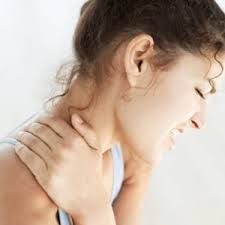“Aaah I am not able to bear this pain” exclaimed a middle aged lady pointing out at her neck. She was been suffering with it since a year now. Had tried with all local application with temporary relief. Recent days neither balms nor hot fermentation gave her any relief. She came to us with her agony. What was she suffering with? ... following few lines will clear the doubt ...
What is Cervical Spondylitis?
“Neck pain due to wear and tear”
Vertebrae are bones that join together to form the entire backbone. In between the vertebrae are cushion-like structures called “inter vertebral discs”. Age related wear and tear can cause the joints between the vertebrae to degenerate. In addition, it also causes the gradual destruction of the inter vertebral discs.
When the nerve roots start getting pressed upon due to these changes, it can lead to symptoms of nerve compression.
The condition affects males and females equally though it takes off earlier in males. It usually runs a slow and progressive course.
What triggers off the pain in the neck?

Long standing degeneration (wearing away) of the vertebrae and the intervertebral discs is the primary cause behind this disorder. Now this can be triggered due to a number of reasons such as:
• Advancing age
• History of neck injury in the past
• Occupational trauma – lifting heavy loads on head, gymnastics, working on the computer for long hours
• Sleeping in sitting position repetitively during journeys
• Occupations requiring minute concentration wherein people work with bent neck for long time
• Holding the telephone between the ears and shoulders for long durations repeatedly
Whatever be the trigger for cervical spondylitis, the common changes that are seen in the cervical spine are as follows:
• Abnormal growths or ‘spurs’ on the vertebrae
• Dehydration and subsequent loss of elasticity in the intervertebral discs
• Bulging of the discs from between two vertebrae
• Stiffness of neck ligaments (tissue connecting the neck bones and muscles)
Symptoms
The neck hurts so much!
Neck pain and stiffness is one of the earliest presentations of cervical spondylitis. Some of the characteristic features of this condition are:
• Chronic or episodic pain and stiffness in the neck and shoulder region
• Pain may radiate (travel) from neck to shoulders, arms, forearms, hands, lower part of the head, upper back
• Coughing, sneezing, other movements of the neck may worsen symptoms
• Along with pain, there may be abnormal sensations (tingling numbness), loss of sensation, weakness in any of the above regions
• Sensation of loss of balance
Diagnosis and Tests
How would you know its Cervical Spondylitis?
The history of your complaints and the examination findings often provide most of the details necessary to diagnose cervical spondylitis. However, some tests may be required to confirm the diagnosis as well as to assess the extent of damage that has already occurred. It can also be used to track the progress of the condition over a period of time.
Here are some of the tests that can be done to confirm the diagnosis:
• X-ray of the cervical spine (neck) – detects the development of spurs (bony outgrowths) on the vertebrae
• CT (Computerized Tomography) scan
• MRI (Magnetic Resonance Imaging) spine – determines the extent of neural damage, if any
Complications
How bad can it get?
Cervical spondylitis can cause increased pressure on the spinal cord over a period of time and this is one of the major complications. It can result in symptoms such as:
• Progressive loss of muscle function
• Loss of sensations of the skin
• Unsteady gait
• Spastic movements
Homeopathic Treatment
Homeopathy indeed has substantial relief to offer to patients of cervical spondylitis. The medicines provide with significant relief in the pain and stiffness that is associated with the disease. In addition, the treatment can also help to slow down the progress of the ailment over a period of time.
Besides the above, other symptoms such as tingling, numbness and weakness are also seen to improve in most cases. Range of mobility of the neck can get better too provided the disease has not progressed too far.
In advanced cases where the disease has cause significant damage already, it may only be possible to palliate the symptoms of the patient.
Self Care Tips
• Maintain a healthy weight; los that extra weight, if any
• Eat a varied diet including plenty of calcium rich foods (sesame seeds, green leafy vegetables, ragi , sardines , almonds, broccoli, milk products )
• Exercise regularly to maintain neck strength, flexibility, range of motion
• Always wear your seat belt while travelling in a car
• When working on a computer or watching TV, take frequent breaks and avoid long periods of inactivity
• Use thin pillow and avoid placing more than one pillow under your head, sleep on a firm mattress
-------------------------------------------------------------------------------------------------------------------------------------




